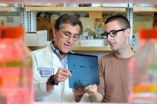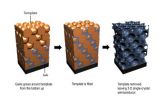(Press-News.org) UCLA life scientists and colleagues have produced one of the first high-resolution genetic maps for African American populations. A genetic map reveals the precise locations across the genome where DNA from a person's father and mother have been stitched together through a biological process called "recombination." This process results in new genetic combinations that are then passed on to the person's children.
The new map will help disease geneticists working to map genetic diseases in African Americans because it provides a more accurate understanding of recombination rates among that population, said the senior author of the research, John Novembre, a UCLA assistant professor of ecology and evolutionary biology and of bioinformatics. The map could help scientists learn the roots of these diseases and discover genes that play a key role in them.
The study was published July 20 in the online version of the journal Nature Genetics and will be published in the print edition at a later date.
"Research aimed at finding disease variants will be improved by this tool, which could lead to better medications to help ameliorate the effects of those disease variants," Novembre said. "Health researchers can use a recombination map to refine where a disease gene might be."
Prior to this research, which was conducted by scientists from seven institutions, recombination had mainly been studied in European populations.
"Now we have a map for African Americans that researchers can use as a tool, instead of using a European map or an African map," said Novembre, a member of UCLA's Interdepartmental Program in Bioinformatics.
A second, independent study, led by David Reich at Harvard University and Simon Myers at Oxford University, used a similar approach to infer an African American recombination map. That research was published this week in Nature.
"While recombination rates between populations are very similar when you look at the broadest scales of the genome, we start to see variation in recombination between populations when we zoom in," said Daniel Wegmann, a UCLA postdoctoral scholar in Novembre's laboratory and the lead author of the study. "There are clear differences in recombination between Africans and Europeans, and African Americans tend to have a map that is a mixture between the African and European map, reflecting the mixture that took place between these two groups.
"If the position of a mutation is unknown and you want to pinpoint a gene linked to a disease, then recombination is important to help reveal in what region the gene lies," Wegmann said.
The mixture of African and European ancestry typical in the DNA of African Americans is reflected in recombination rates, Novembre said.
"No high-resolution recombination map has been inferred before for populations where the individuals have ancestry from different parts of the globe," Novembre said. "African Americans represent a unique combination of African and European ancestry. We found that if you know an African recombination rate for one region of the genome and you know the European rate, the African American rate sits about 80 percent of the way between the two. That is interesting, because the ancestry of African American DNA, on average, is 80 percent from African ancestral sources and 20 percent from European ancestral sources. The recombination rate reflects the ancestry."
The life scientists used an innovative method involving population genetic models in which they scanned the individual genomes of 2,565 African Americans, as well as 299 African Caribbeans, to study where in the genome each had African ancestry, where they had European ancestry, and where the "switch points" were that mark the location where the ancestry of a DNA segment changes.
Novembre and colleagues studied the ancestry of DNA segments to reconstruct where recombinations have occurred.
"The key is to uncover the ancestry of each segment of the genome," Novembre said. "Switch points enable us to identify recombination 'hot spots,' where recombination rates are high."
Explaining recombination, Novembre said, "When we pass on DNA to our children, we stitch together the DNA we received from our mother and father. The resulting DNA alternates between DNA from your mother and from your father, and the recombination points are the boundaries. Those points could be chosen uniformly across the whole chromosome, but studies have found that recombinations occur in some locations in the chromosome more than in others. Locations in the chromosome have particular recombination rates — the rate at which break points occur in that location.
"It is difficult to identify, by studying chromosomes directly, where the stitch points are between maternal and paternal DNA," he said. "In individuals of mixed ancestry, however, such as African Americans and African Caribbeans, we can identify switch points between African ancestry and European ancestry. These switch points mark locations where recombinations have occurred at some point in the past."
"There are regions of our map that differ from what we would expect," Wegmann said. "We see locations where there are deficiencies in recombination, and they line up with the locations of mutations that rearrange the genome and flip a piece of DNA to invert it. When you have a normal copy of the DNA and an inverted copy of the DNA, one from your mother and one from your father, this inversion suppresses recombination."
Of some 3 billion base pairs in a person's genome, the scientists were able to resolve recombination rates down to 50,000 base pairs of the DNA — an impressive figure.
Comparing this African American recombination map with that of other populations enables researchers to locate recombination hot spots, which have highly elevated rates of recombination.
In addition to the applications for disease mapping, the research provides broad insights into the fundamental biological process of recombination.
"We want to learn how recombination rates vary across the genome," Novembre said.
###
Nelson Freimer, director of the UCLA Center for Neurobehavioral Genetics and a professor of psychiatry at the Semel Institute for Neuroscience and Human Behavior at UCLA, is a principal investigator on the research, along with Novembre and Wegmann, and helped to organize the collaborative effort to bring together the large sample used in the study.
The effort was made possible by the cooperation of investigators from five large consortia: the Genetic Study of Atheroscleoris Risk (GeneSTAR) consortium; the Genetic Network of Arteriopathy (GENOA) consortium; the Chicago Asthma Genetics (CAG) and the Collaborative Study on the Genetics of Asthma (CSGA) consortia; the Genetic Research on Asthma in the Africa Diaspora (GRAAD) consortium; and the Severe Asthma Research Program (SAARP).
The consortia were funded by the STAMPEED (SNP Typing for Association with Multiple Phenotypes from Existing Epidemiological Data) program run by the National Heart, Lung and Blood Institute of the National Institutes of Health. Novembre's research was also funded by the Searle Foundation.
UCLA is California's largest university, with an enrollment of more than 38,000 undergraduate and graduate students. The UCLA College of Letters and Science and the university's 11 professional schools feature renowned faculty and offer 328 degree programs and majors. UCLA is a national and international leader in the breadth and quality of its academic, research, health care, cultural, continuing education and athletic programs. Six alumni and five faculty have been awarded the Nobel Prize.
For more news, visit UCLA Newsroom and UCLA News|Week and follow us on Twitter.
Life scientists use novel technique to produce genetic map for African Americans
2011-07-25
ELSE PRESS RELEASES FROM THIS DATE:
Cellular stress can induce yeast to promote prion formation
2011-07-25
It's a chicken and egg question. Where do the infectious protein particles called prions come from? Essentially clumps of misfolded proteins, prions cause neurodegenerative disorders, such as mad cow/Creutzfeld-Jakob disease, in humans and animals. Prions trigger the misfolding and aggregation of their properly folded protein counterparts, but they usually need some kind of "seed" to get started.
Biochemists at Emory University School of Medicine have identified a yeast protein called Lsb2 that can promote spontaneous prion formation. This unstable, short-lived protein ...
NASA catches 3 tropical cyclones at 1 time
2011-07-25
It's not often that a satellite can capture an image of more than one tropical cyclone, but the GOES-13 satellite managed to get 3 tropical cyclones in two ocean basins in one image today. Bret and his "sister" Cindy are racing through the North Atlantic, while another area tries to develop far to their south. "Cousin" Dora is still a hurricane in the eastern Pacific.
In infrared image taken on July 22 at 0845 UTC (4:45 a.m. EDT), GOES-13 captured Tropical Depression Bret, Tropical Storm Cindy in the north Atlantic and low pressure area associated with a tropical wave ...
Northwest Forest Plan has unintended benefit – carbon sequestration
2011-07-25
CORVALLIS, Ore. – The Northwest Forest Plan enacted in 1993 was designed to conserve old-growth forests and protect species such as the northern spotted owl, but researchers conclude in a new study that it had another powerful and unintended consequence – increased carbon sequestration on public lands.
When forest harvest levels fell 82 percent on public forest lands in the years after passage of this act, they became a significant carbon "sink" for the first time in decades, absorbing much more carbon from the atmosphere than they released. At the same time, private ...
New target found for nitric oxide's attack on salmonella bacteria
2011-07-25
A new target for nitric oxide has been revealed in studies of how it inhibits the growth of Salmonella. This bacterium is a common cause of food-poisoning.
"Nitric oxide is naturally produced in the nose and the gut and other tissues in the body to ward off infection," explained the senior author of the paper, Dr. Ferric Fang. He is a University of Washington (UW) professor of laboratory medicine, microbiology and medicine.
Nitric oxide – not to be confused with nitrous oxide, the laughing gas in dentists' offices – is similar to the preservatives in hotdogs, Fang ...
2 genetic variations predict second cancers after radiation for children with Hodgkin lymphoma
2011-07-25
A genome-wide association study published in the August issue of Nature Medicine has found two tiny genetic variations that can predict which patients with Hodgkin's lymphoma are most likely to develop radiation-induced second cancers years after treatment. Knowing in advance who is at risk could help physicians tailor treatment to reduce the risks for patients who are most susceptible to long-term damage.
Hodgkin's lymphoma is one of the most treatable cancers, with more than 90 percent of patients surviving after a combination of radiation and chemotherapy. But nearly ...
Graphene's 'quantum leap' takes electronics a step closer
2011-07-25
Writing in the journal Nature Physics, the academics, who discovered the world's thinnest material at The University of Manchester in 2004, have revealed more about its electronic properties.
Research institutes and universities around the world are already looking at ways to build devices such as touch-screens, ultrafast transistors and photodetectors.
Now the research from the creators of the material promises to accelerate that research, and potentially open up countless more electronic opportunities.
The researchers, from the universities of Manchester, Madrid ...
Pocket chemistry: DNA helps glucose meters measure more than sugar
2011-07-25
CHAMPAIGN, Ill. — Glucose meters aren't just for diabetics anymore. Thanks to University of Illinois chemists, they can be used as simple, portable, inexpensive meters for a number of target molecules in blood, serum, water or food.
Chemistry professor Yi Lu and postdoctoral researcher Yu Xiang published their findings in the journal Nature Chemistry.
"The advantages of our method are high portability, low cost, wide availability and quantitative detection of a broad range of targets in medical diagnostics and environmental monitoring," Lu said. "Anyone could use it ...
New photonic crystals have both electronic and optical properties
2011-07-25
CHAMPAIGN, Ill. — In an advance that could open new avenues for solar cells, lasers, metamaterials and more, researchers at the University of Illinois have demonstrated the first optoelectronically active 3-D photonic crystal.
"We've discovered a way to change the three-dimensional structure of a well-established semiconductor material to enable new optical properties while maintaining its very attractive electrical properties," said Paul Braun, a professor of materials science and engineering and of chemistry who led the research effort.
The team published its advance ...
Epigenetic 'memory' key to nature versus nurture
2011-07-25
Researchers funded by the Biotechnology and Biological Sciences Research Council (BBSRC) at the John Innes Centre have made a discovery, reported this evening (24 July) in Nature, that explains how an organism can create a biological memory of some variable condition, such as quality of nutrition or temperature. The discovery explains the mechanism of this memory – a sort of biological switch – and how it can also be inherited by offspring.
The work was led by Professor Martin Howard and Professor Caroline Dean at the John Innes Centre, which receives strategic funding ...
Soft spheres settle in somewhat surprising structure
2011-07-25
Latex paints and drug suspensions such as insulin or amoxicillin that do not need to be shaken or stirred may be possible thanks to a new understanding of how particles separate in liquids, according to Penn State chemical engineers, who have developed a method for predicting the way colloidal components separate based on energy.
"The ongoing assumption was that if you have a mixture of different sized particles in a liquid, the faster-settling particles will end up on the bottom," said Darrell Velegol, professor of chemical engineering. "We found that in many cases it ...





